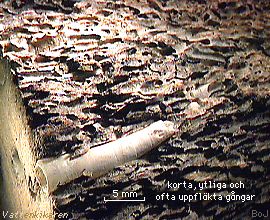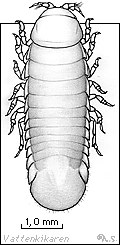|

Distribution in scandinavian waters
|
Maximum length: 0,5 cm.
Appearance: Because gribbles usually attack wood "en
mass", the wood surface quickly becames sharp and uneven
because of all the holes and cavities.
They are a light grey-brown in colour, often
with darker markings. Gribbles can roll up like a ball.
Depth: Sea-level to unknown depth.
Environment: Live close to the coast in sea water
impregnated wood.
Misc: In contrast to the shipsworm
(that has made the calcareous tube above), gribbles can leave their
piece of wood and swim away to another. The female lays her eggs in
her tunnel. When a large number of young are born they dig sideways
and can create immense damage to the wood. Although gribbles do not
dig very deeply into the wood, the attacked area flakes off, and if
the wood is attacked from many directions, thickness can be reduced
by as much as 2 cm per annum.
Besides cellulose in the wood, gribbles also
consume the different fungi that attack the wood.
The gribble exists globally in the northern
hemisphere.
With a magnifying glass it is possible to observe small
one millimetre large dwellings in the form of a bottle on the back of
the gribble. These dwellings have been built by single celled ciliates
that belong to the group Folliculinidae.
Classification: Gribbles are part of the group woodlice which
is a crustacean under the arthropods.
|



